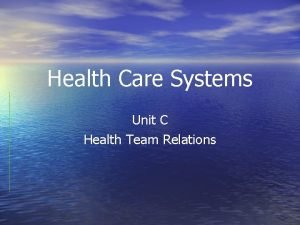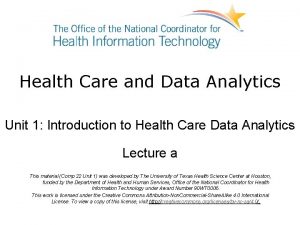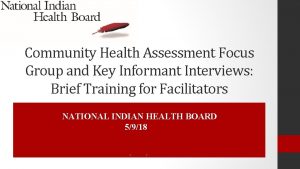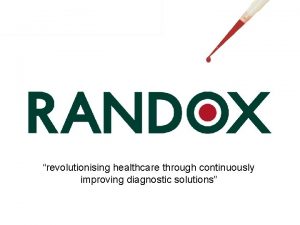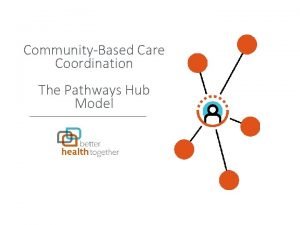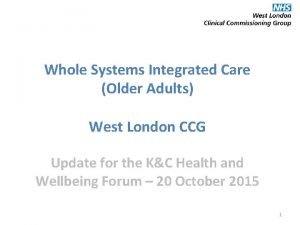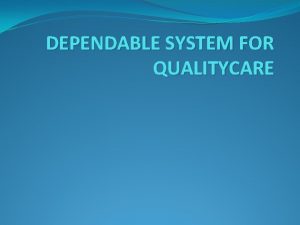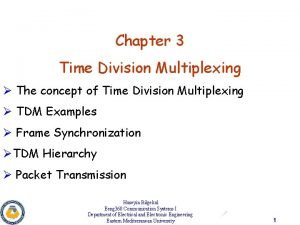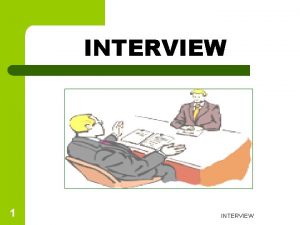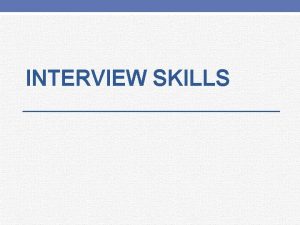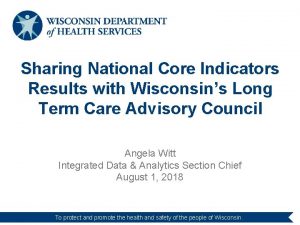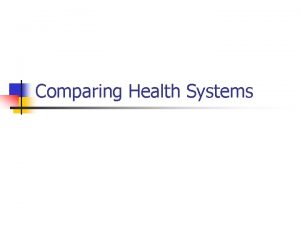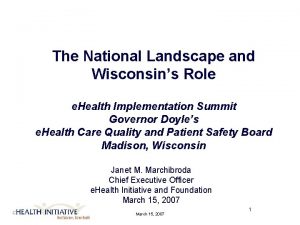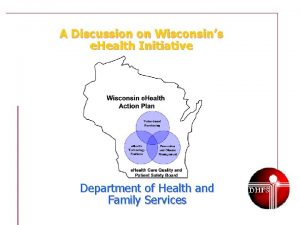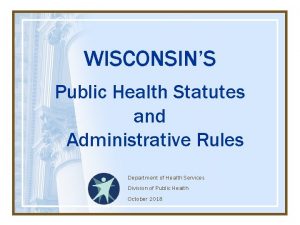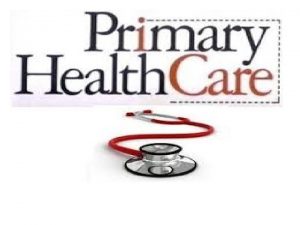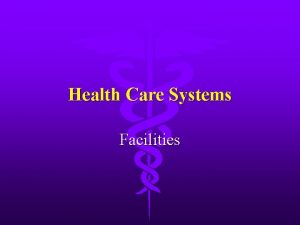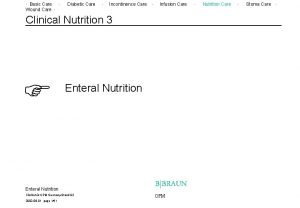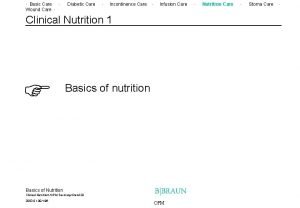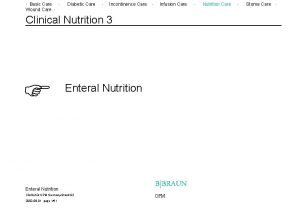Interview Results Wisconsins Health Care Systems Use of



























- Slides: 27

Interview Results – Wisconsin’s Health Care Systems Use of Team-Based Care for Chronic Disease Management PAMELA J. MYHRE, MSN, APNP, CDE WNA GRANT CONSULTANT PALLIATIVE AND HOSPICE NP, CROSSING RIVERS HEALTH

Outline Team-based care in-depth interviews with Wisconsin health systems: • Background and overview • Team-based care definition • Interview findings • Next steps • Discussion and questions

Background and Overview �Purpose/Goal �Interview Guide and Question Development �Timeline �Recruitment �Interview Participation �Post Interview

Team-Based Care Definition Provided “The provision of health services to individuals, families, and/or their communities by at least two health providers who work collaboratively with patients and their caregivers - to the extent preferred by each patient - to accomplish shared goals within and across settings to achieve coordinated, high-quality care. ” Mitchell et al. 2012. Core principles & values of effective team-based health care*

Findings �Barriers & Factors �Successes & Benefits �Team Members �Work Flow & Design

Barriers & Factors When Implementing Team-Based Care

Barriers & Factors �Lack of Standardization & Evidence-Based Protocols Uniformity, evidence & definitions: roles, structure, care, work flow, care team �Team Culture & Care Team Relationships Hierarchical structure, physicians relinquishing work, trust, collaboration, historically siloed*, different training and education, mutual respect, entire team engagement �Staff Capacity Quantity, skills/knowledge, roles/positions (i. e. , nurses, MAs) , lack of training in LEAN processes and flow �Demonstrating Value Payors, providers, parent organization, all clinical and non-clinical staff

Barriers & Factors (continued) �Buy-in Stakeholders, leaders, providers*, administrator*, clinical and non-clinical staff, patients*, everyone, nurses, “top down” �Investment/Financial Monetary adoption and maintenance support �Payment Structure/Reimbursement Fee for service, “paid for episodes of care and not longitudinal well coordinated care delivery”, prior authorization*

Barriers & Factors (continued) �Organizational Structure Number of patients per physician expectation, processes, Accountable Care Organization �Resources Training capacity, EHR/EMR access and availability, hiring resources �Communication Mode, frequency, inclusivity/exclusivity, transparency * �Physical Layout/Environment Proximity to other team members*, shared working space, access to computers, area dedicated for communication �Other Patients • Goal Setting • Metrics

Implementing Team-Based Care Successes & Benefits

Successes & Benefits �Staff/Team Satisfaction Increased clinical and non-clinical staff satisfaction, collaboration *, improved relationships, “wouldn’t work in another place that doesn’t have team” �Patient Outcomes/Quality Metrics Improved patient health outcomes, transparency understood by entire team*, increased # of patients seen by physician (30%) �Patient Care/Satisfaction/Access Decreased wait time, “one stop shop”, increased level of respect and trust from patient* �Communication Improved communication with health care team and patient & amongst health care team members

Successes & Benefits (continued) �Screenings/Lab More comprehensive and timely tests accomplished, increased number of preventative tests* �Top-of-License Practice Further education & training provided, additional or advanced credentialing achieved (“Growing” the staff), RN working w/more complex needs in self management (DM & HTN)* �Interprofessional Collaboration Workgroups, interaction, and communication established or enhanced among multidisciplinary health professionals �Other Standardization of Care • Bridge Behavioral Health • Depth of Roles • Patient. Centered Medical Home Certification/Recognition

Successes & Benefits (continued) �EMR/EHR/HIT Advancements * Best practice alerts* My Chart advancements* New ways to use patient portal (DM data entry-BG results) – clinical alerts to patient (“would you please document my foot exam? ”) Registry: New HTN patients (a negative-positive? )* Clean the data regularly* Protocols* �Standardized rooming processes


Advice For Implementing Team-Based Care

Communicate effectively process, goals, strategies, best practices Strategically plan & gain knowledge talk with others, pilot test or start at small scale, /start slowly, develop team-based care definition beforehand, define goal or purpose as well as metrics and success Establish workgroup or committee frontline, steering committee, advisory board, formal and informal leaders Get buy-in from everyone leadership, financing, providers, patients, all health care professionals and team members Establish two-way communication open to feedback, understand what’s working well, lessons learned Engage and seek input from everyone leadership, financing, providers, patients, all health care professionals and team members Educate & inform team-based care concept, update changes, highlight success at any scale, provide strategic plan, setup training schedule

Team Members Engaged in Team-Based Care

Team Members Least • Community Health Worker • Dental Hygienist or Other Dental Role • Dentist • Emergency Medical Professional/ Technician or Paramedic • Home Health Aide • Nursing Assistant • Patient Navigator Some • Appointment Specialist • Behavioral Health Specialist • Case Manager • Health Coach or Educator • Medical or Clinical Lab Tech • Medical Records/HIT Tech or Informaticist • Medical Specialist • Nurse Leader • Receptionist • Therapies Most • Administrative Leader • Administrative/ Support Staff • Care Coordinator • Certified Diabetes Educator • Doctor of Osteopathy • Licensed Practical Nurse • Medical Assistant • Nurse Practitioner • Pharmacy Tech • Registered Dietitian or Nutritionist • Registered Nurse All • Pharmacist • Physician Assistant • Social Worker

Workflow & Design To Support Team-Based Care Implementation --What is the current model?

Workflow & Design � Workgroups Interprofessional groups or committees with a focus Hypertension population focus workgroup made-up of clinical staff, MD, pharmacist, analytics, and EMR designers High-risk patient focus led by care coordinators and made-up of RNs, pharmacists, and social workers � Protocols and Standards of Care Evidence-based guidelines - CDE * Hypertension readings, new diabetes diagnosis, referral to behavioral health Anticoagulation & refill protocols run by nurses/pharmacists (with oversight) � Support Tools and EMR/EHR/HIT Smart Set, registry, telehealth, digiceuticals, Health link Evidence based algorithm built into charts

Workflow & Design (continued) � Role Responsibilities and Top-of-License Practice* Pharmacy leads/handles all hyperlipidemic, angiotensin receptor blockers, anticoagulation medications – or insulin titration (management) RN triage and teaching – RN with Medicare Annual Wellness visits MA completes template according to chronic condition � Team Composition and dynamics Psychologist available on site (goal for many). 1 MD : 1 MA, passers/schedulers for all care teams, 2 MD : 1 RN, shared external care coordinators Two way communication – team takes input from all sides � Pre-visit Planning Chart review, contacting patient a day before appointment, review for gaps in care, arrange for lab tests, have pending orders prepared/ready for provider in patient record

Workflow & Design (continued) � Huddles (sometimes with Huddle sheet – Huddle board) Daily, beginning of each shift, as issues arise* Everyone, only clinical staff, entire team besides physicians Chronic Disease Huddle (Team, provider, RN, Pharmacy) – meets monthly � Patient Engage patient and family, collect patient satisfaction Patient Goals * � Transparency Metrics, shared goals, patient outcomes, celebrate successes, “scripted” talk about importance of controlled HTN/A 1 c lowering

Next Steps For Implementing Team-Based Care

Next Steps �Utilize interview findings �Continue conversation �Stay engaged and keep informed �Reference patient-centered team-based care model

Discussion & Questions

Frosting… �“Believe in the unimaginable!” We did it! �TEAMSTEPPS – effective team building �Intermountain Healthcare - Behavioral Health Model (UTAH) �Grocery walk-through with dietitian �MA Academy (information, education, speakers, updates, burnout, vaccines, depression). RN Academy is next. �“Extraordinary health care – one patient at time. ” �“Treat employees as your most valuable asset and as precious commodities. ”

THANK YOU! To Interview Participants � Andy Anderson, MD, MBA – Chief Medical Officer - System and Executive Vice President � Holly Boisen, RN - QI Project Manager � Robyn Borge, MD - Department of Family Medicine, Director of Patient Care Innovations � Jo. Ellen Frawley, APNP, CDE � Chris Kastman, MD - Medical Director for Population Health at GHC � Mary Kerrigan, BSN, RN - Regional Director of Operations � Shelley Key RN, BSN - Clinical Staff Educator � Mary Beth Kingston, RN, MSN, NEA-BC, Executive Vice-President & Chief Nursing Officer � Jill Lindwall MSN, RN - Ambulatory Care Coordination Program Manager � Laura Magstadt MBA, MSN, RN, NE-BC - Regional Vice President Operations � Scott Schuldes APNP - Associate Medical Director � Ellen Wermuth MD – Family Practice
 Primary secondary tertiary medical care
Primary secondary tertiary medical care Health and social care values unit 2
Health and social care values unit 2 Health team relations
Health team relations Health care systems research network
Health care systems research network Chapter 2 health care systems
Chapter 2 health care systems Unit 1 health care systems
Unit 1 health care systems Health and social component 3
Health and social component 3 Ehis eurostat
Ehis eurostat Key informant interview questions community assessment
Key informant interview questions community assessment Randox health test results
Randox health test results Duty of care outcome care certificate
Duty of care outcome care certificate Magnetul atrage
Magnetul atrage Palliative care versus hospice care
Palliative care versus hospice care Vietuitoare care se inmultesc prin oua
Vietuitoare care se inmultesc prin oua Care sunt simturile prin care sunt evocate
Care sunt simturile prin care sunt evocate Care certificate answers 13
Care certificate answers 13 Hip fracture care clinical care standard
Hip fracture care clinical care standard Hub care coordination systems
Hub care coordination systems Distintasec
Distintasec St charles integrated care centre
St charles integrated care centre Recovery oriented systems of care
Recovery oriented systems of care Dependable systems for quality care
Dependable systems for quality care Decision support systems and intelligent systems
Decision support systems and intelligent systems Principles of complex systems for systems engineering
Principles of complex systems for systems engineering Embedded systems vs cyber physical systems
Embedded systems vs cyber physical systems Elegant systems
Elegant systems Use and care of the library
Use and care of the library Block diagram of tdm system
Block diagram of tdm system


